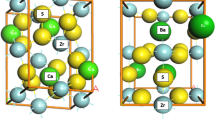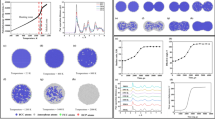Abstract
Classical atomistic simulation techniques have been used to investigate the energies of hydrogen defects in Mg2SiO4 and Mg2GeO4 spinels. Ringwoodite (γ-Mg2SiO4) is considered to be the most abundant mineral in the lower part of the transition zone and can incorporate large amounts of water in the form of hydroxyls, whereas the germanate spinel (γ-Mg2GeO4) corresponds to a low-pressure structural analogue for ringwoodite. The calculated defect energies indicate that the most favourable mechanisms for hydrogen incorporation are coupled either with the reduction of ferric iron or with the creation of tetrahedral vacancies. Hydrogen will go preferentially into tetrahedral vacancies, eventually leading to the formation of the hydrogarnet defect, before associating with other negatively charged point defects. The presence of isolated hydroxyls is not expected. The same trend is observed for germanate, and thus γ-Mg2GeO4 could be used as a low-pressure analogue for ringwoodite in studies of water-related defects and their effect on physical properties.


Similar content being viewed by others
References
Bell DR, Rossman GR (1992) Water in earth’s mantle: the role of nominally anhydrous minerals. Science 255:1391–1397
Blanchard M, Wright K, Gale JD (2005) Atomistic simulation of Mg2SiO4 and Mg2GeO4 spinels: a new model. Phys Chem Miner 32:332–338
Bolfan-Casanova N, Keppler H, Rubie DC (2000) Water partitioning between nominally anhydrous minerals in the MgO–SiO2–H2O system up to 24 GPa: implications for the distribution of water in the earth’s mantle. Earth Planet Sci Lett 182:209–221
Braithwaite JS, Wright K, Catlow CRA (2003) A theoretical study of the energetics and IR frequencies of hydroxyl defects in forsterite. J Geophys Res 108(B6):2284 (art. no.)
Brodholt JP, Refson K (2000) An ab initio study of hydrogen in forsterite and a possible mechanism for hydrolytic weakening. J Geophys Res 105 (B8):18977–18982
Catlow CRA (1977) Oxygen incorporation in the alkaline earth fluoride. J Phys Chem Solids 38:1131–1136
Clowe CA, Popp RK, Fritz SJ (1988) Experimental investigation of the effect of oxygen fugacity on ferric ferrous ratios and unit cell parameters of four natural clinoamphiboles. Am Miner 73:487–499
CRC Handbook of Chemistry and Physics (1980–81) Weast RC (ed) 61st edn. CRC Press Inc, FL, USA
Dachille F, Roy R (1960) High pressure studies of the system Mg2GeO4–Mg2SiO4 with special reference to the olivine–spinel transition. Am J Sci 258:225–246
Demouchy S (2004) Water in the earth’s interior: thermodynamics and kinetics of hydrogen incorporation in olivine and wadsleyite. PhD Thesis, Universität Bayreuth, Bayerisches Geoinstitut, pp156
Dyar MD, Mackwell SJ, McGuire AV, Cross LR, Robertson JD (1993) Crystal chemistry of Fe3+ and H+ in mantle kaersutite: implications for mantle metasomatism. Am Miner 78:968–979
Gale JD, Rohl AL (2003) The General Utility Lattice Program (GULP). Mol Simul 29:291–341
Haiber M, Ballone P, Parrinello M (1997) Structure and dynamics of protonated Mg2SiO4: an ab-initio study. Am Miner 82:913–922
Hercule S, Ingrin J (1999) Hydrogen in diopside: diffusion, kinetics of extraction-incorporation, and solubility. Am Miner 84:1577–1587
Jacobsen SD, Smyth JR, Spetzler H, Holl CM, Frost DJ (2004) Sound velocities and elastic constants of iron-bearing hydrous ringwoodite. Phys Earth Planet Int 143–144:47–56
Kleppe AK, Jephcoat AP, Smyth JR (2002a) Raman spectroscopic study of hydrous γ-Mg2SiO4 to 56.5 GPa. Phys Chem Miner 29:473–476
Kleppe AK, Jephcoat AP, Smyth JR, Frost DJ (2002b) On protons, iron and the high-pressure behavior of ringwoodite. Geophys Res Lett 29(21):2021
Kohlstedt DL, Mackwell SJ (1998) Diffusion of hydrogen and intrinsic point defects in olivine. Zeitschrift für Physikalische Chemie 207:147–162
Kohlstedt DL, Keppler H, Rubie DC (1996) Solubility of water in the α, β and γ phases of (Mg,Fe)2SiO4. Contrib Miner Petrol 123:345–357
Kudoh Y, Kuribayashi T, Mizobata H, Ohtani E (2000) Structure and cation disorder of hydrous ringwoodite, γ-Mg1.89Si0.98H0.30O4. Phys Chem Miner 27:474–479
de Leeuw NH, Parker SC (2000) Density functional theory calculations of proton-containing defects in forsterite. Radiat Eff Defects Solids 154:255–259
Libowitzky E (1999) Correlation of O-H stretching frequencies and O–H⋯O hydrogen bond lengths in minerals. Monatshefte für Chemie/Chem Mon 130:1047–1059
Martin RF, Donnay G (1972) Hydroxyl in the mantle. Am Miner 57:554–570
McCammon CA, Frost DJ, Smyth JR, Laustsen HMS, Kawamoto T, Ross NL, Van Aken PA (2004) Oxidation state of iron in hydrous mantle phases: implications for subduction and mantle oxygen fugacity. Phys Earth Planet Int 143–144:157–169
Mott NF, Littleton MJ (1938) Conduction in polar crystals. I. Electrolytic conduction in solid salts. Trans Faraday Soc 34:485
Nakamoto K, Margoshes M, Rundle RE (1955) Stretching frequencies as a function of distances in hydrogen bonds. J Am Chem Soc 77:6480–6486
O‘Neill HSC, McCammon CA, Canil D, Rubie DC, Ross II CR, Seifert F (1993) Mössbauer spectroscopy of mantle transition zone phases and determination of minimum Fe3+ content. Am Miner 78:456–460
Parker SC, Cooke DJ, Kerisit S, Marmier AS, Taylor SL, Taylor SN (2004) From HADES to PARADISE—atomistic simulations of defects in minerals. J Phys Condens Matter 16:S2735–S2749
Price GD, Parker SC, Leslie M (1987) The lattice dynamics and thermodynamics of the Mg2SiO4 polymorphs. Phys Chem Miner 15:181–190
Ringwood AE (1975) Composition and petrology of the earth’s mantle. Mc Graw-Hill, New York, p 630
Sastre G, Gale JD (2003) Derivation of an interatomic potential for germanium- and silicon-containing zeolites and its application to the study of the structures of octadecasil, ASU-7, and ASU-9 Materials. Chem Mater 15:1788–1796
Schröder KP, Sauer J, Leslie M, Catlow CRA, Thomas JM (1992) Bridging hydroxyl groups in zeolitic catalysts: a computer simulation study. Chem Phys Lett 188:320–325
Skogby H, Rossman GR (1989) OH− in pyroxenes: an experimental study of incorporation mechanisms and stability. Am Miner 74:1059–1065
Smyth JR, Holl CM, Frost DJ, Jacobsen SD, Langenhorst F, McCammon CA (2003) Structural systematics of hydrous ringwoodite and water in Earth’s interior. Am Miner 88:1402–1407
Wright K, Catlow CRA (1994) A computer simulation study of OH defects in olivine. Phys Chem Miner 20:515–518
Wright K, Catlow CRA (1996) Calculations on the energetics of water dissolution in wadsleyite. Phys Chem Miner 23:38–41
Acknowledgements
This study was partially supported by the EU through the Human Potential Program HPRM-CT-2000-0056. K. Wright would like to thank the Royal Society for funding, and J.D. Gale gratefully acknowledges the support of the Government of Western Australia through a Premier’s Research Fellowship. We also thank EPSRC for provision of computing resources under Grant no. GR/SO6233/01.
Author information
Authors and Affiliations
Corresponding author
Rights and permissions
About this article
Cite this article
Blanchard, M., Wright, K. & Gale, J.D. A computer simulation study of OH defects in Mg2SiO4 and Mg2GeO4 spinels. Phys Chem Minerals 32, 585–593 (2005). https://doi.org/10.1007/s00269-005-0036-z
Received:
Accepted:
Published:
Issue Date:
DOI: https://doi.org/10.1007/s00269-005-0036-z




